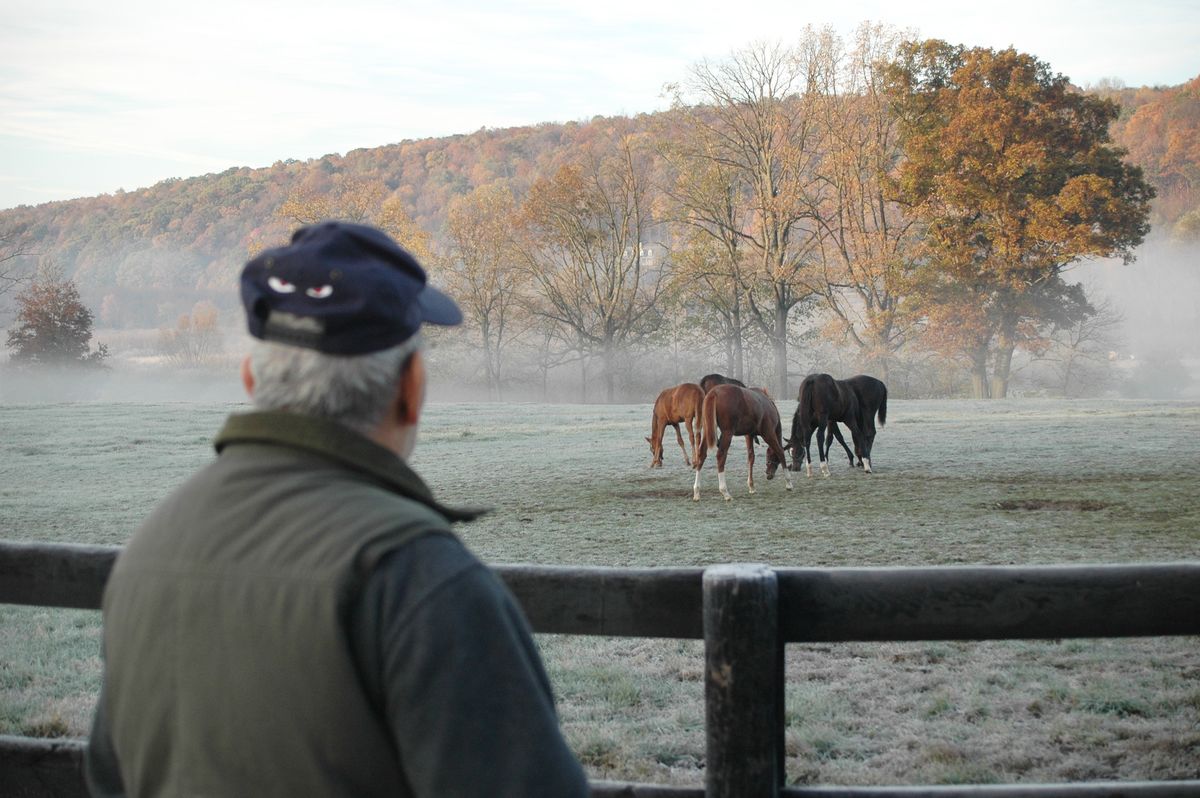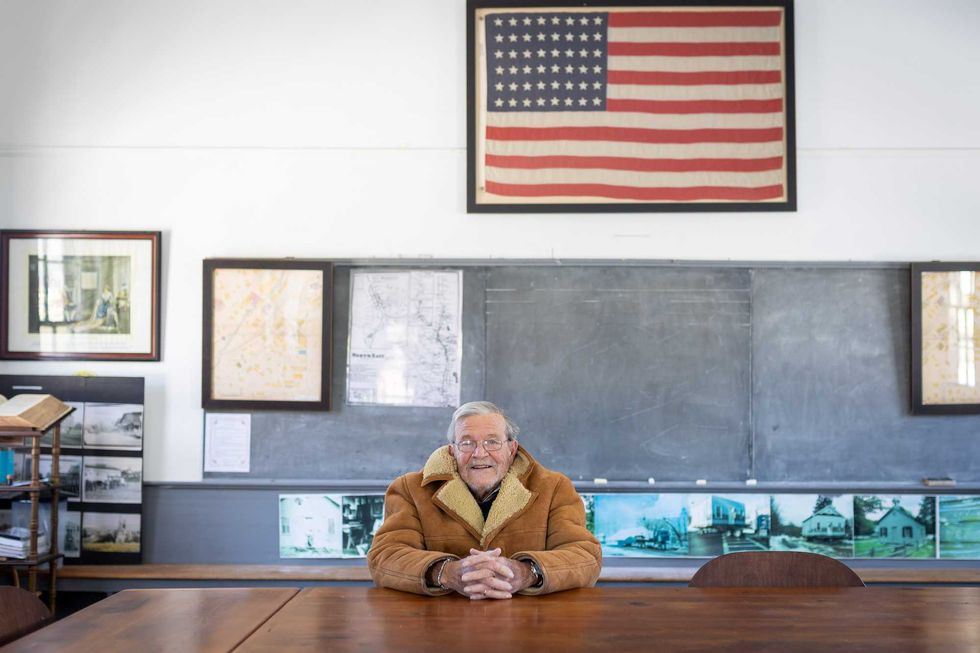Remembering Frank Stella, artist and farmer

Misty stillness on an October morning in Smithfield found Frank Stella observing a few of his horses. The image was captured by Stella’s visiting friend, Martin Francis.
Martin Francis

Misty stillness on an October morning in Smithfield found Frank Stella observing a few of his horses. The image was captured by Stella’s visiting friend, Martin Francis.
Aprofound commitment to the notion of rural life and farm ownership centered Frank Stella in the Smithfield Valley in Amenia, New York. His artistic talents, spanning 60 years, brought renown first as a pioneer minimalist and later as an abstract painter and sculptor, earning him numerous awards. His decades at his Amenia farm allowed him to pursue the breeding and racing of his horses.
In 2009 Stella was one of ten recipients of the National Medal of Arts from President Barack Obama, awarded in a White House ceremony.
Stella’s rural Smithfield Valley community and The Smithfield Church mourned news of his death that had occurred on Saturday, May 4, at his home in Manhattan. He was 87, just short of his 88th birthday. The following day, on Sunday, the little congregation gave thanks to God for all in Frank Stella that was good, kind, and faithful, imbuing him with an extraordinary imagination that poured into his art, his deep sense of color, and his unique gifts brought through paint to canvas.
When in residence at his Smithfield horse farm, Delahanty Stock Farm, neighbor to The Smithfield Church, Stella and his wife, Harriet, would happily attend concerts or suppers, enjoying conversations with the locals. The Smithfield Valley Association events were also likely to attract their attendance and relaxed participation.
Noticing that Stella was in the audience for a solo organ concert being performed by Kent Tritle, organist of the New York Philharmonic, Director of the New York Oratorio Society, and organist at the Cathedral of St. John the Divine, the Rev. Douglas Grandgeorge, pastor of the church, seized the opportunity to introduce the two to each other. As the pastor reached for superlatives in praise of both giants in the arts, Stella interrupted with his own self-introduction. “Here, I am a farmer,” Stella said simply.
Stella’s local friendships were long and significant. During an interview on Wednesday, May 15, Nan Cassidy spoke of her own decades of association with Stella, firm admiration, and Stella’s enduring friendship with her mother, Ethel Doshna, until her death at 104.
“He was always kind, always made Ethel feel special, always bringing a present to remember her birthdays, Cassidy recalled.
“He was just the sweetest person,” Cassidy said. “He always made people feel special.”
They met in the 1970s, nearly 50 years back, when Cassidy and her husband, Jim Cassidy, were managing the farm that at that time was owned by a partnership. Frank Stella went on to buy out the other partners, and the farm became Delahanty Stock Farm.
“He was a wonderful person, so kind. He just loved coming to the farm,” Cassidy said.
A favorite story that has endured describes the Cassidys’ first encounter with Stella. In the early years, Nan and Jim Cassidy were living at the farm and Nan was busy inside making dinner while Jim and Ethel’s husband, Mike, were outside waiting for someone who was coming to see about painting the barn. A young man arrived, clothing and shoes splattered with paint.
“The painter is here,” Mike called in to the kitchen, but it wasn’t the barn painter, it was Frank Stella, owner of the farm and a different kind of painter.
“On one occasion, we met at one of the Amenia restaurants and Frank gave Ethel a gift of a tiny titanium sculpture that he had fashioned, Nan Cassidy recalled. It wasn’t clear to Ethel how the little piece should stand. “Think of it as a puzzle; you can put it together any way you want,” he told Ethel.
“What you see is what you see.” Frank Stella said in 1966 of his art. The directness of the saying has lasted.
In remembrance of two of his paintings that had hung in corporate offices at the World Trade Center, but been lost on 9/11, Stella installed a stainless steel sculpture at 7 World Trade Center Plaza in 2021, a piece titled “Jasper’s Split Star.” The sculpture was inspired by his own 1962 painting titled “Jasper’s Dilemma,” a tribute to Sharon, Conn. artist Jasper Johns.
He nurtured the passion for thoroughbred racing and breeding of horses, a passion pursued at his Smithfield farm. He enjoyed the excitement of turf racing and had earned stature in the racing world as a breeder of winning New York-thoroughbred horses.
Stella’s horses raced at notable tracks including Belmont, Arlington, and Saratoga. Stella’s preference was turf racing and he always put the welfare of the horse first, according to the New York Thoroughbred Breeders’ Association.
Ralph Fedele sits at a desk in the historic Irondale Schoolhouse, which he led the effort to relocate to downtown Millerton.
MILLERTON — After serving for 12 years on the North East Town Board, Ralph Fedele says he has only one regret.
“I wish I could be called a ‘local,’” he joked with a warm, booming laugh.
Fedele moved to Millerton from New York City 37 years ago, in 1988, and has since worn many hats — volunteer, historian, advocate, elected official — yet he still doesn’t believe he’s earned that title.
“I’m a transplant,” he said matter of factly. “I’m from the city.”
Before settling in Millerton, Fedele spent 25 years working in merchandising at JCPenney.
His roots, however, trace back to Rhinebeck, where he grew up on a 97-acre farm and enjoyed what he describes as an idyllic childhood.
“It was marvelous,” he said, with a twinkle of nostalgia in his eyes. As a boy, he climbed apple trees, spent hours in the family barn’s hayloft, played with neighbors until sunset, and helped his Sicilian grandmother — his nonna — in the garden. Today, Fedele wears her ring. “Any time I’m a little depressed or I want to remember,” he said, “I can talk to her.”
Growing up with an Italian grandmother sparked a lifelong love of history and culture. That curiosity eventually took Fedele to Italy, where he visited the church in which his grandmother was baptized. “Because I love history so much, I wanted to know where my grandmother was from, so I traveled to her village in Sicily.”
Along the way, he uncovered another piece of family history. His great-grandfather, Giovanni Nicolini, was a noted Italian sculptor whose work still stands outside Palermo’s Teatro Massimo, the largest opera house in Italy. Fedele later made a pilgrimage there and photographed his ancestor’s name on the bronze plaque outside of the theater.

The Irondale Schoolhouse
Years after settling in Millerton full time, Fedele was driving north on Route 22 when he spotted an old, classic building and couldn’t stop thinking about it.
“It was in dire straits,” he recalled. “Right on the road, but beautiful. I remember thinking, ‘Wouldn’t that be a great building to move into the village?’”
That moment would eventually turn into Fedele’s lasting legacy.
He left his post at the North East Historical Society to found Friends of the Irondale Schoolhouse, leading an eight-year effort to “move, restore, and repurpose the building.”
Supervisor Chris Kennan said the project remains inseparable from Fedele’s name. “Every time I pass by the Schoolhouse, I think of Ralph,” Kennan said. “It was his vision and persistence that enabled this dream to become a reality.”
Fedele joked that people may have thought he was crazy during the lengthy restoration. “I was a tyrant,” he said with a laugh. “I really made sure that we were able to get it done.” The effort required coordination with the state, the county, village and town officials, and his newly assembled nonprofit board.
As a self-proclaimed history buff, Fedele didn’t stop at the restoration. He found a list of students in old records and did what any determined historian would do. He opened the telephone book and started making calls.
Eventually, he tracked down one of the schoolhouse’s original students — Mary (Mechare) Leitch — who, at the age of 101, returned to the building after renovations were complete.
“It was a marvelous time,” smiled Fedele. “I was so happy to see her.”
‘Trust is earned’
Today, even though he won’t call himself a local, Fedele is a familiar fixture in town. You can find him each week enjoying conversation and a cup of coffee at Talk of the Town Deli, or getting stopped in town by neighbors and friends for a chat.
“I have gained the trust and confidence of a lot of people,” Fedele said. “It comes a little bit at a time. Trust is earned.”
Not only has Fedele served as a town board member, he has volunteered for Townscape and served as the president of the North East Historical Society. He was also one of the first advocates of preserving history by fixing toppled gravestones at the Spencer’s Corners Burying Ground.
His service was formally recognized at his final Town Board meeting through a resolution commending his three four-year terms as councilman, citing his “good humor, kindness to all and deep concern for the community’s senior citizens and for those living on fixed incomes.”
An emotional Fedele addressed the room with a mantra he often repeats. “When you leave, leave this place a little bit better than you found it,” he said. “That’s what I have always tried to do.”
Neighbors react
During the public comment, several residents stood to thank Fedele.
Claire Goodman, a member of the village Zoning Board of Appeals and Townscape volunteer, said Fedele was among the first to welcome her to Millerton.
“Whether we’re standing out in the cold, scrubbing tombstones at Spencer’s Corners, or ringing the bell at the schoolhouse, you always have such grace and you’re such a gentleman.” She added, “The way you laugh, it opens my heart.”
Kathy Chow, who serves on the Conservation Advisory Council and the Climate Smart Task Force, referred to Fedele as a “pitbull,” adding, “We all have hard things that we do, and we keep pushing at it, but you’re the one who makes me think I can keep going.”
Fedele describes his retirement from the town board as bittersweet. “I’m going to miss this,” he said. “I really am.”
Mad Rose Gallery on Route 44 in the Village of Millerton is decked out with lights and decorations to celebrate the holiday season.
MILLERTON — The Village of Millerton is inviting residents and businesses to enter its annual house decorating contest, with judging now underway through Dec. 28.
Awards will be presented in several categories, including Best Lights, Most Creative, Best Overall and Best Commercial Front.
Entries will be evaluated by a panel of judges using established criteria. Creativity will be judged based on originality, variety of materials used and the use of homemade vs. commercially made decorations. Appearance will consider color coordination, balance and overall attractiveness, while effort will reflect the time and energy put into preparation and presentation.
Judging will be conducted by drive-by observation between 6 p.m. and 11 p.m., and displays must be clearly visible from the street side of the house at night. People and pets may not be included as part of the design.
Winners in each category will receive a gift basket, gift certificates and recognition in The Millerton News. Awards will be distributed on Friday, Jan. 9, 2026.
The contest is open to residents and businesses in the Village of Millerton and the Town of North East. Entry forms can be obtained from Village Hall or at villageofmillerton-ny.gov.